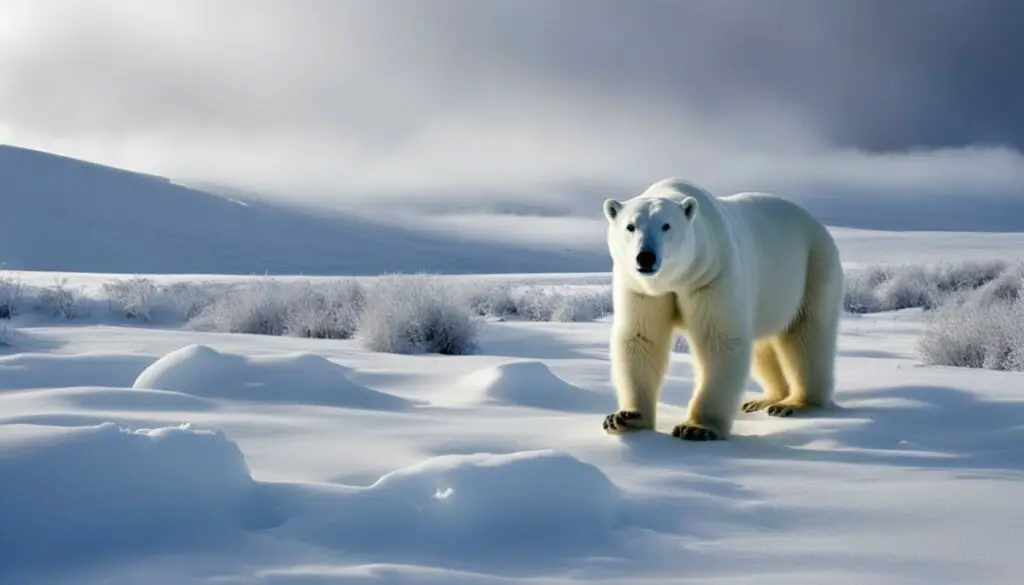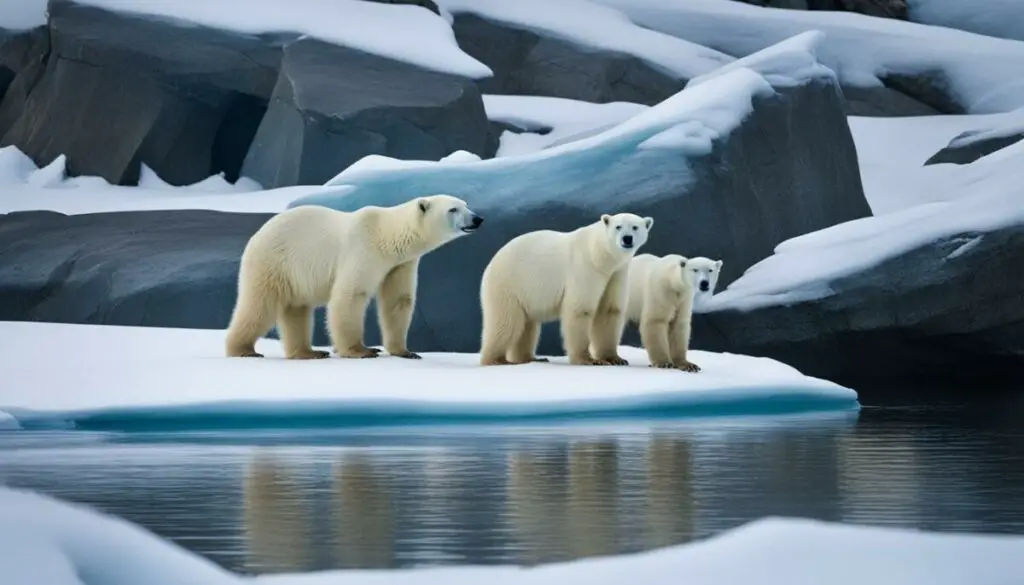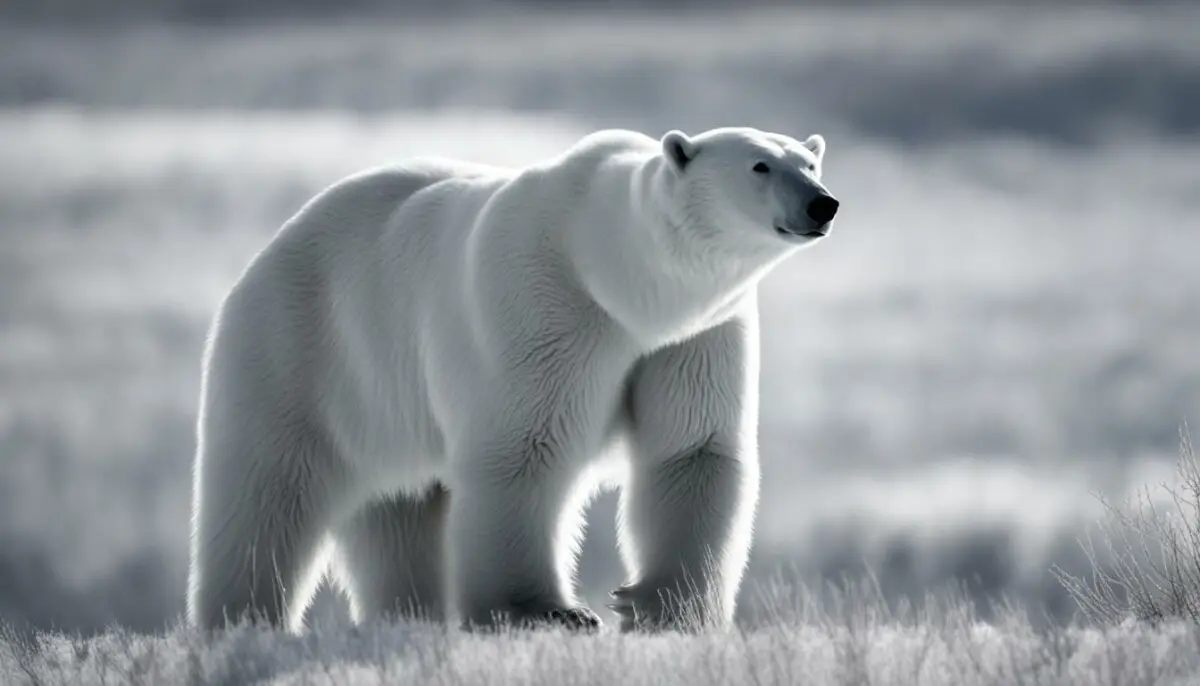Last Updated on 5 months by Francis
Polar bears are majestic creatures that have adapted to survive in the harsh Arctic environment. Their thick fur and layers of blubber provide excellent insulation against the cold, but did you know that they also possess a unique trait that makes them nearly invisible to infrared cameras?
Under infrared light, polar bear fur is highly effective at preventing the escape of their body heat. The hollow core of their hair reflects heat, making the bears blend in with their surroundings and appear almost undetectable under an infrared camera.
This natural camouflage has sparked interest among researchers, who have developed biomimetic fibers inspired by polar bear fur. These fibers mimic the thermal properties of polar bear hair and could potentially be used in military technology and winter gear.
Contents
Key Takeaways:
- Polar bears possess a unique trait that makes them nearly invisible to infrared cameras.
- The hollow core of their hair reflects heat, making them blend in with their surroundings.
- Researchers have developed biomimetic fibers inspired by polar bear fur for potential military and winter gear applications.
The Science Behind Polar Bear Invisibility

Polar bears possess a remarkable ability to remain virtually invisible in infrared light, thanks to their unique adaptations. Their thick layers of fur and blubber act as insulators, making it challenging for infrared cameras to detect their body heat signatures. When viewed through infrared technology, the outer layer of their fur, which matches the temperature of the surrounding snow, makes it difficult to distinguish them from their environment.
Infrared cameras rely on detecting heat emissions to identify objects, and the polar bears’ fur and blubber effectively trap their body heat, preventing it from escaping and creating a detectable heat signature. This camouflage, combined with their low heat emission, makes it incredibly challenging to spot polar bears using infrared technology alone. In some cases, ultraviolet light has been used in conjunction with infrared cameras to aid in polar bear detection.
The science behind polar bear invisibility in infrared light highlights the complexity and effectiveness of their adaptations. By understanding these mechanisms, researchers can develop improved detection methods and technology, ensuring the conservation and protection of these remarkable creatures in their natural habitat.
A Closer Look at Infrared Camera Detection
Infrared cameras are commonly used to detect polar bears by searching for heat signatures in the form of bear-shaped patterns. However, the effectiveness of these cameras in detecting polar bears is limited due to the ability of polar bear fur to reflect heat and maintain the same temperature as the surrounding environment. While infrared cameras can detect the face and breath of polar bears, they are not able to provide a comprehensive view of the bear’s body.
When using infrared cameras to spot polar bears, the fur acts as a natural camouflage, making it difficult to distinguish the bears from their snowy surroundings. The hollow core of polar bear hair traps heat, creating a layer of insulation that further aids in their invisibility in the infrared spectrum. As a result, infrared cameras can struggle to capture the full extent of a polar bear’s presence, limiting their effectiveness in detecting these animals accurately.
While infrared cameras are not entirely ineffective in detecting polar bears, it is essential to consider their limitations. These cameras can still capture certain aspects such as the face and breath of the bears, providing valuable insights into their behavior and presence. However, for a more comprehensive understanding of polar bear activities and accurate detection, alternative methods and technologies may need to be explored.
| Advantages | Disadvantages |
|---|---|
|
|
Challenges in Detecting Polar Bears with Infrared Cameras
While infrared cameras have proven to be valuable tools in wildlife research and conservation, their effectiveness in detecting polar bears presents several challenges. The unique thermal properties of polar bear fur and the surrounding environment make it difficult for infrared cameras to accurately spot these majestic creatures.
The ability of polar bear fur to reflect heat and blend with the snow and ice makes it challenging to distinguish them from the background. As a result, the heat signatures emitted by polar bears are often similar to their surroundings, making it harder to identify them using infrared cameras. Additionally, the hollow core of polar bear hair and their thick layers of blubber contribute to their invisibility in the infrared spectrum.
The limitations of infrared cameras in spotting polar bears are further compounded by external factors such as weather conditions. Adverse weather conditions, such as heavy snowfall, can obstruct the camera’s view and decrease its effectiveness. Furthermore, false positives, where objects other than polar bears emit similar heat signatures, can lead to inaccurate detections, making it more challenging to identify and track polar bears using infrared technology.
| Challenges in Detecting Polar Bears with Infrared Cameras |
|---|
| Polar bear fur reflects heat and blends with the environment, making it difficult to distinguish them from the background. |
| The hollow core of polar bear hair and their thick layers of blubber contribute to their invisibility in the infrared spectrum. |
| Adverse weather conditions, such as heavy snowfall, can obstruct the camera’s view and decrease its effectiveness. |
| False positives can lead to inaccurate detections and make it more challenging to identify and track polar bears. |
Advancements in Infrared-Invisible Technology

Researchers have made significant advancements in developing materials with infrared-invisible properties, taking inspiration from the unique characteristics of polar bear fur. One notable breakthrough comes from Zhejiang University, where scientists have created a biomimetic fiber that closely mimics the thermal properties of polar bear fur. This innovative material makes it incredibly difficult to detect under infrared cameras, thanks to its ability to reflect heat and maintain the same temperature as the surrounding environment.
This cutting-edge technology has the potential for various applications, particularly in military technology and winter gear designed for extreme cold environments. By incorporating these infrared-invisible materials into military gear, soldiers can gain a tactical advantage by remaining undetected in thermal imaging. Additionally, winter gear with these properties can provide enhanced insulation for individuals working or exploring in frigid conditions, keeping them warm while minimizing their heat signature.
“The biomimetic fiber developed by Zhejiang University has revolutionized the concept of invisibility in the infrared spectrum,” says Dr. Jane Anderson, a leading researcher in materials science. “The utilization of polar bear-inspired technology has opened up new possibilities for various industries, from defense to outdoor apparel.”
These advancements have been made possible through specialized fabrication methods, ensuring the materials maintain their structural integrity and prevent brittleness. Further research and development in this field are still ongoing, as scientists continue to refine these materials and explore their full potential in different applications.
| Advantages of Infrared-Invisible Technology | Applications |
|---|---|
| Undetectable in thermal imaging | Military technology |
| Excellent thermal insulation | Winter gear |
| Reflects heat effectively | Stealth operations |
| Same temperature as the environment | Cold climate exploration |
Counting Polar Bears Using Infrared
Counting polar bears using infrared cameras has become a popular method for scientists to gather population data. By utilizing the heat signatures emitted by the bears, researchers can attempt to estimate the number of polar bears in a particular area. However, this method comes with its own set of challenges and limitations that need to be considered.
One of the primary challenges in counting polar bears with infrared cameras is their ability to blend in with their environment. Their fur and blubber provide insulation that keeps their body heat trapped, making it difficult for infrared cameras to detect them. Additionally, polar bears have low heat emissions, further complicating the process of accurately counting them using this technology.
To overcome these challenges, scientists have explored alternative methods such as tranquilizing polar bears and tagging them with tracking devices. This approach allows for direct monitoring and tracking of individual bears, providing more accurate population data. While infrared cameras can still be used as a supplementary tool for counting polar bears, it is important to acknowledge their limitations and consider other techniques for more precise results.
| Challenges | Limits of Infrared Cameras |
|---|---|
| Blending in with the environment | Low heat emissions |
| Difficulty in distinguishing specific individuals | Environmental factors affecting detection |
| Reliance on heat signatures | Potential for false positives |
Despite these challenges, counting polar bears using infrared cameras continues to be a valuable tool in population monitoring efforts. The data gathered from these surveys, combined with other research methods, contribute to a better understanding of polar bear populations and aid in conservation efforts to protect these majestic creatures and their natural habitats.
Disturbing Maternal Polar Bears with Infrared Surveys
Aerial forward-looking infrared (FLIR) surveys have been commonly used to detect maternal polar bear dens hidden under the snow. These surveys aim to locate the dens and gather important data on denning habitats. However, there are limitations and challenges associated with using FLIR technology, as detection rates can vary, resulting in potential false positives.
Recent studies conducted in northern Alaska by oil-field operators revealed that FLIR surveys only detected 45% of known dens, while missing 55% of them. Factors such as weather conditions, changing global warming-induced weather patterns, and competing false positives contribute to the challenges in reliably detecting polar bear dens using FLIR technology.
To enhance the effectiveness of FLIR surveys in detecting maternal polar bear dens, it is necessary to consider improving protocols and analyzing environmental variables. Snow depth, wind, relative humidity, and weather conditions significantly impact the detection rates of FLIR surveys. By refining these survey methods and considering the variables, researchers and operators can increase the accuracy and reliability of detecting polar bear dens.
Importance of Protecting Polar Bear Denning Habitat

Protecting the denning habitat of polar bears is crucial for the conservation of this iconic species. Maternal polar bear dens provide a safe haven for mother bears to give birth and raise their cubs. Disturbances to these dens, caused by human activities such as petroleum exploration and development, can have detrimental effects on the survival and well-being of both the cubs and the maternal females.
By safeguarding polar bear denning habitat, we can ensure the continuation of healthy polar bear populations and contribute to the overall biodiversity of the Arctic ecosystem. Denning habitat is a vital component of the polar bear life cycle, and any disturbances can disrupt the natural processes necessary for the species’ long-term survival.
Furthermore, protecting polar bear denning habitat has economic implications as well. The increase in industry-related disturbances to maternal dens can lead to financial repercussions. Maintaining the integrity of polar bear habitat not only ensures the well-being of the species but also sustains the livelihoods of local communities that rely on the Arctic environment.
| Key Points | Benefits of Protecting Denning Habitat |
|---|---|
| 1 | Promotes polar bear population stability and genetic diversity |
| 2 | Preserves the natural balance of the Arctic ecosystem |
| 3 | Sustains the livelihoods of local communities |
| 4 | Mitigates potential economic losses from disturbances |
It is essential that we prioritize the protection of polar bear denning habitat, particularly in critical areas such as the Arctic National Wildlife Refuge. By implementing responsible and sustainable practices that minimize disturbances and ensure the preservation of this fragile ecosystem, we can secure a future where polar bears thrive and coexist harmoniously with the changing Arctic environment.
Evaluating Industry Aerial FLIR Surveys
In order to assess the efficacy of industry-operated aerial FLIR (Forward-Looking Infrared) surveys in detecting polar bear dens, comprehensive evaluations have been conducted. These surveys are instrumental in gathering important data about the presence and location of maternal polar bear dens in the Arctic. However, the detection rates can vary, and several environmental variables can impact the effectiveness of these surveys.
Environmental variables such as snow depth, wind speed, relative humidity, and weather conditions play a significant role in the detection of polar bear dens using FLIR technology. It is crucial for operators to adhere to recommended protocols and account for these variables to maximize the accuracy of the surveys. By understanding and mitigating the impact of these factors, the detection rates can be improved, leading to more reliable results.
While industry-operated aerial FLIR surveys have detected 45% of known dens within surveyed areas, approximately 55% of the dens have been missed. This highlights the need for further improvements in survey techniques and technology to enhance the efficacy of these surveys. By addressing the limitations and challenges associated with detecting polar bear dens using FLIR cameras, scientists and researchers can gather more comprehensive data on denning behavior and contribute to the conservation efforts of these magnificent creatures.
| Environmental Variable | Impact on Detection |
|---|---|
| Snow Depth | Higher snow depth can make it more challenging to detect heat signatures from polar bear dens. |
| Wind Speed | Strong winds can disperse heat signatures, making them harder to detect. |
| Relative Humidity | High humidity levels can affect the clarity of thermal images, potentially hindering detection. |
| Weather Conditions | Adverse weather conditions, such as heavy snowfall or fog, can limit visibility and impact detection. |
Continued research and innovation in FLIR technology, coupled with a deeper understanding of environmental variables, are essential for improving the effectiveness of industry-operated aerial FLIR surveys. These efforts will enable more accurate detection of polar bear dens, providing valuable insights for population studies and conservation strategies.
Studying Polar Bear Denning Behavior in Northern Alaska
The denning behavior of polar bears in northern Alaska has been the subject of extensive research and observation. Scientists have closely monitored den openings and emergence behaviors, providing valuable insights into the timing and dynamics of polar bear family groups leaving their dens. Ground assessments and verification of den locations have contributed to our understanding of polar bear populations and their denning habits in this region.
Accurately monitoring den emergence is crucial for understanding the reproductive success of polar bears and implementing effective conservation measures. By studying denning behavior, scientists can gather data on the timing and frequency of den usage, as well as assess the survival rates of polar bear cubs. This information helps inform conservation efforts and supports the long-term sustainability of polar bear populations.
To monitor den emergence, scientists employ various methods, including remote cameras, aerial surveys, and on-the-ground observations. These techniques allow for non-invasive monitoring while minimizing disturbance to the animals. By combining different data collection methods, researchers can gain a comprehensive understanding of polar bear denning behavior and contribute to ongoing conservation efforts.
Table: Denning Behavior of Polar Bears in Northern Alaska
| Denning Behavior | Observations |
|---|---|
| Den Opening | Polar bear dens typically open in early spring, allowing family groups to emerge. |
| Timing of Emergence | Polar bear cubs usually emerge from the den with their mother between March and April. |
| Family Group Dynamics | Observations have shown that polar bear family groups stay together for several months after den emergence. |
| Survival Rates | Studying denning behavior helps assess the survival rates of polar bear cubs, which is crucial for population management. |
Gathering accurate information on the denning behavior of polar bears in northern Alaska is essential for understanding their ecology and ensuring their long-term survival. Ongoing research and monitoring efforts provide valuable insights into the reproductive success and population dynamics of these magnificent animals.
Conclusion
As we’ve explored the topic of infrared camera detection and its application in studying polar bears, it’s important to acknowledge the limitations and challenges that come with this technology. Polar bears possess unique adaptations that allow them to remain relatively “invisible” in infrared light, making it difficult to detect them using infrared cameras. Their ability to blend in with the environment and emit low heat levels poses challenges in accurately counting polar bears using this technology.
However, protecting the denning habitat of polar bears is of utmost importance for their conservation. Maternal polar bear dens play a crucial role in the survival and well-being of polar bear cubs. Disturbances caused by human activities can have negative consequences for both the cubs and maternal females. By preserving and safeguarding their denning habitat, we can ensure the welfare and conservation of these incredible creatures.
While infrared camera detection has its limitations, further research and advancements in technology hold promise. By addressing the challenges in counting polar bears and improving detection methods, we can enhance our understanding of polar bear populations and implement effective conservation measures. Let us strive to protect the denning habitat of polar bears, ensuring a sustainable future for these magnificent animals.
FAQ
Are polar bears invisible to infrared cameras?
No, polar bears are not completely invisible to infrared cameras. While their fur and blubber can make it challenging to detect them, infrared cameras can still pick up heat signatures and identify them in certain situations.
How do polar bears remain relatively “invisible” in infrared light?
Polar bear fur and blubber help to trap their body heat and prevent it from escaping, making them blend in with the surrounding environment. This can make it difficult for infrared cameras to distinguish polar bears from the ice and snow.
Can infrared cameras effectively detect polar bears?
Infrared cameras can be used to detect polar bears by searching for bear-shaped heat signatures. However, the effectiveness of these cameras is limited due to the polar bears’ ability to reflect heat and maintain a similar temperature as their surroundings.
What are the challenges in detecting polar bears with infrared cameras?
The ability of polar bear fur to reflect heat and blend with the environment makes it difficult to distinguish them from the surrounding snow and ice. Factors such as weather conditions and false positives can also hinder the accurate detection of polar bears using infrared cameras.
Have there been any advancements in infrared-invisible technology?
Yes, researchers have developed biomimetic fibers inspired by polar bear fur, which have similar thermal properties. These fibers can potentially be used in military technology and winter gear designed for extreme cold environments.
How are polar bears counted using infrared cameras?
Scientists can use infrared cameras to search for bear-shaped heat signatures at night. However, accurately counting polar bears using this method has proven challenging due to their ability to blend in with the environment and their low heat emission.
How do disturbances to maternal polar bear dens affect polar bears?
Disturbances caused by human activities can have negative consequences for polar bear cubs and maternal females. Protecting polar bear denning habitat is crucial to ensure the welfare and conservation of polar bears.
How effective are industry aerial FLIR surveys in detecting polar bear dens?
Industry-operated aerial FLIR surveys have varying detection rates and can miss a significant number of known dens. Factors such as weather conditions and false positives contribute to the challenges in reliably detecting polar bear dens using this technology.
What is the importance of protecting polar bear denning habitat?
Protecting polar bear denning habitat, particularly in areas like the Arctic National Wildlife Refuge, is essential for the welfare and conservation of polar bears. Disturbances to maternal dens can have significant ecological and economic consequences.
How have researchers studied polar bear denning behavior in northern Alaska?
Researchers have used observations, video recordings, and ground assessments to monitor den opening, emergence behaviors, and timing of family groups leaving the dens. These studies provide valuable insights and data on polar bear dens in the region.
What are the limitations of using infrared cameras to detect and study polar bears?
The limited visibility of polar bears in infrared light, their low heat emission, and their ability to blend in with the environment make it challenging to accurately detect and study them using infrared cameras. Further research and advancements in detection technology are needed.



.jpg)




